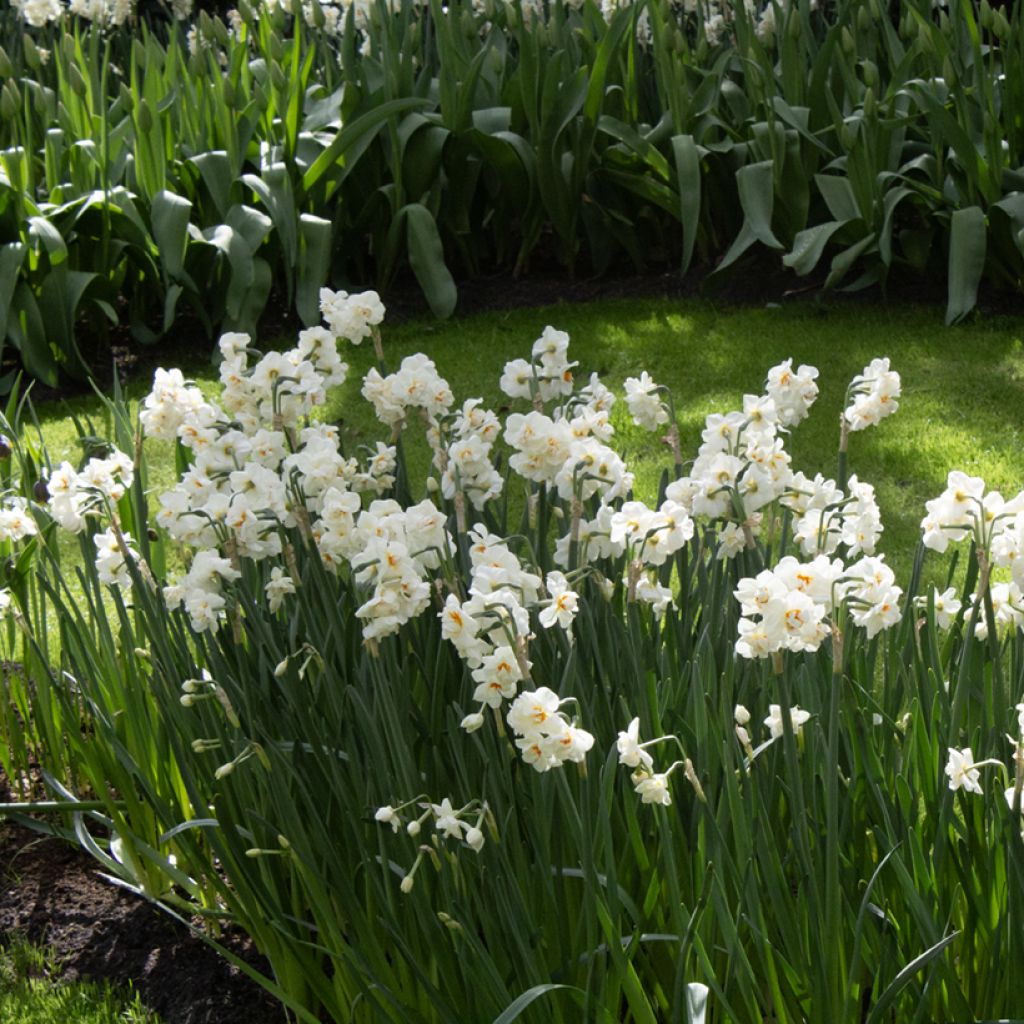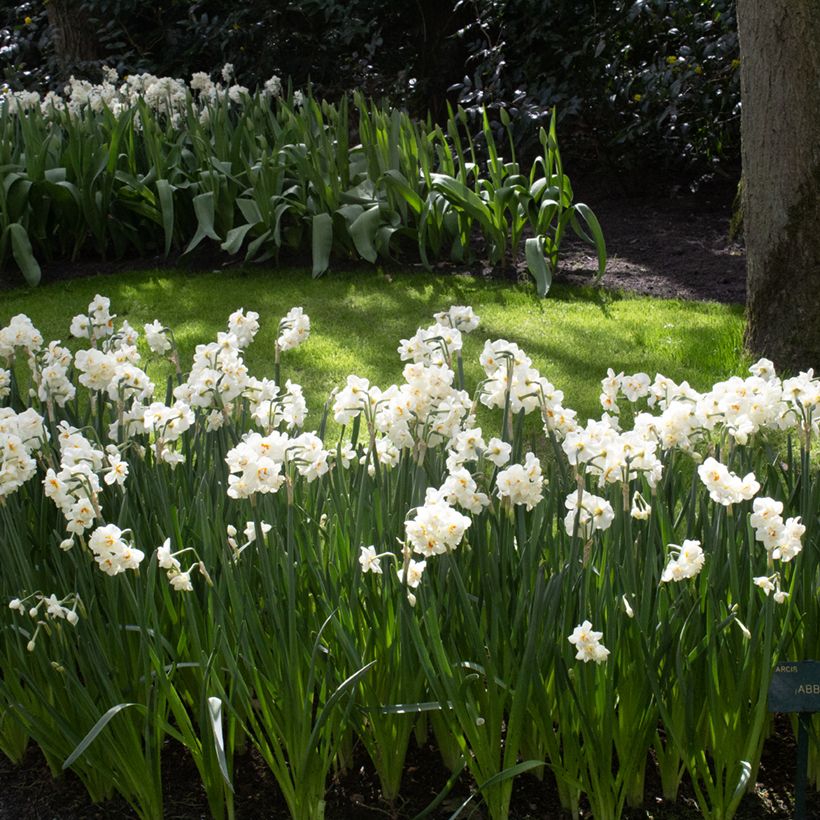

Narcissus Abba - Daffodil
Narcissus Abba - Daffodil
Narcissus tazetta Abba
Paperwhite, Bunch-flowered Narcissus, Polyanthus Narcissus
This plant carries a 6 months recovery warranty
More information
We guarantee the quality of our plants for a full growing cycle, and will replace at our expense any plant that fails to recover under normal climatic and planting conditions.
From €5.90 for pickup delivery and €6.90 for home delivery
Express home delivery from €8.90.
Does this plant fit my garden?
Set up your Plantfit profile →
Description
Narcissus 'Abba' produces up to 5 small double flowers on each stem, with a spicy fragrance. Each flower consists of a collar of white sepals surrounding a small double central crown, tinted orange and yellow towards the centre. This narcissus blooms in mid-spring but adapts well to forcing for early flowering indoors.
Narcissus 'Abba' comes from a Mediterranean botanical species, Narcissus tazetta, also known as bouquet narcissus or Constantinople narcissus. Narcissus belongs to the amaryllidaceae family. The Narcissus genus includes about 50 species found mainly in the western Mediterranean, but also in Africa and Asia. The 'Abba' narcissus, introduced in 1984 in the Netherlands, is a horticultural hybrid obtained by Jac. M. van Dijk. The plant produces a flowering stem of about 30 cm high. Each stem bears 3 to 5 small bicoloured flowers, 4 to 5 cm in diameter and highly fragrant. Each flower consists of a translucent ivory white perianth surrounding a small corolla of marigold orange and translucent white petals. The deciduous foliage is linear and disappears a few weeks after flowering, reappearing in late winter.
There is such a variety of narcissus that you can enjoy them for three months in spring without ever getting tired. They all have in common the ability to naturalise easily, a love for yellow and white, and often emit sweet fragrances. These are all reasons to grow them in large clumps (at least 20 bulbs) for a multiplied effect. In borders or flower beds, combine the 'Abba' narcissus with Siberian squill, Greek anemone 'White Splendour', and botanical tulips. A group of Narcissus tazetta in a pot placed near the house or even in a lightly heated room will diffuse an exceptional fragrance. They are simply perfect in bouquets.
Daffodil or Narcissus? In fact, daffodils are a variety of narcissus. They are distinguished by their flowers grouped in pairs or more, and their trumpet-shaped corona, longer than the corolla is wide. Botanical species, such as N. bulbocodium, N. canaliculatus, N. juncifolius, and N. pseudonarcissus, the simple wood daffodil, possess the charm of wild plants and thrive well in rockeries.
For bouquets, it is best not to mix narcissus with other flowers, especially tulips, as the stems of narcissus contain a substance that causes other flowers to wilt quickly. To minimize this effect, dip the ends of the narcissus stems in warm water for 1 to 2 minutes before arranging them with other flowers.
Report an error about the product description
Narcissus Abba - Daffodil in pictures


Plant habit
Flowering
Foliage
Botanical data
Narcissus
tazetta
Abba
Amaryllidaceae
Paperwhite, Bunch-flowered Narcissus, Polyanthus Narcissus
Cultivar or hybrid
Planting and care
Narcissus 'Abba' grows in any well-drained and loosened soil, even limestone, slightly clayey and dry in summer. The results are less good in soils that are too wet or excessively acidic. Plant the bulbs from September to mid-December, at a depth of 15 cm, with a spacing of 8 cm, in a sunny or semi-shaded position (at least 3 hours of sun per day). Do not disturb them and, each year, your narcissus will produce more and more flowers. You can plant them in the lawn. In this case, lift the turf, dig and loosen the soil to a depth of at least 20 cm (the height of a spade). Plant your bulbs, cover with soil and replace the turf. Choose a place where you will not mow too early, as it is necessary to let the narcissus leaves wither before cutting them. It is advisable to water in case of drought, during the flowering period. On the other hand, excessively wet summers are harmful to the bulbs, which may rot. Narcissus bulbs can generally remain in the ground, but they can be dug up once the foliage has turned yellow to protect them from excessive summer rain. Remove faded flowers to promote the accumulation of new reserves in the bulb. After flowering, let the foliage die naturally and only cut it when it turns yellow. If the clumps become too dense, they will flower less well, so they can be divided from July to September when the leaves are dry. You can replant the (undamaged) bulbs immediately.
Planting period
Intended location
Care
This item has not been reviewed yet - be the first to leave a review about it.
Haven't found what you were looking for?
Hardiness is the lowest winter temperature a plant can endure without suffering serious damage or even dying. However, hardiness is affected by location (a sheltered area, such as a patio), protection (winter cover) and soil type (hardiness is improved by well-drained soil).

Photo Sharing Terms & Conditions
In order to encourage gardeners to interact and share their experiences, Promesse de fleurs offers various media enabling content to be uploaded onto its Site - in particular via the ‘Photo sharing’ module.
The User agrees to refrain from:
- Posting any content that is illegal, prejudicial, insulting, racist, inciteful to hatred, revisionist, contrary to public decency, that infringes on privacy or on the privacy rights of third parties, in particular the publicity rights of persons and goods, intellectual property rights, or the right to privacy.
- Submitting content on behalf of a third party;
- Impersonate the identity of a third party and/or publish any personal information about a third party;
In general, the User undertakes to refrain from any unethical behaviour.
All Content (in particular text, comments, files, images, photos, videos, creative works, etc.), which may be subject to property or intellectual property rights, image or other private rights, shall remain the property of the User, subject to the limited rights granted by the terms of the licence granted by Promesse de fleurs as stated below. Users are at liberty to publish or not to publish such Content on the Site, notably via the ‘Photo Sharing’ facility, and accept that this Content shall be made public and freely accessible, notably on the Internet.
Users further acknowledge, undertake to have ,and guarantee that they hold all necessary rights and permissions to publish such material on the Site, in particular with regard to the legislation in force pertaining to any privacy, property, intellectual property, image, or contractual rights, or rights of any other nature. By publishing such Content on the Site, Users acknowledge accepting full liability as publishers of the Content within the meaning of the law, and grant Promesse de fleurs, free of charge, an inclusive, worldwide licence for the said Content for the entire duration of its publication, including all reproduction, representation, up/downloading, displaying, performing, transmission, and storage rights.
Users also grant permission for their name to be linked to the Content and accept that this link may not always be made available.
By engaging in posting material, Users consent to their Content becoming automatically accessible on the Internet, in particular on other sites and/or blogs and/or web pages of the Promesse de fleurs site, including in particular social pages and the Promesse de fleurs catalogue.
Users may secure the removal of entrusted content free of charge by issuing a simple request via our contact form.
The flowering period indicated on our website applies to countries and regions located in USDA zone 8 (France, the United Kingdom, Ireland, the Netherlands, etc.)
It will vary according to where you live:
- In zones 9 to 10 (Italy, Spain, Greece, etc.), flowering will occur about 2 to 4 weeks earlier.
- In zones 6 to 7 (Germany, Poland, Slovenia, and lower mountainous regions), flowering will be delayed by 2 to 3 weeks.
- In zone 5 (Central Europe, Scandinavia), blooming will be delayed by 3 to 5 weeks.
In temperate climates, pruning of spring-flowering shrubs (forsythia, spireas, etc.) should be done just after flowering.
Pruning of summer-flowering shrubs (Indian Lilac, Perovskia, etc.) can be done in winter or spring.
In cold regions as well as with frost-sensitive plants, avoid pruning too early when severe frosts may still occur.
The planting period indicated on our website applies to countries and regions located in USDA zone 8 (France, United Kingdom, Ireland, Netherlands).
It will vary according to where you live:
- In Mediterranean zones (Marseille, Madrid, Milan, etc.), autumn and winter are the best planting periods.
- In continental zones (Strasbourg, Munich, Vienna, etc.), delay planting by 2 to 3 weeks in spring and bring it forward by 2 to 4 weeks in autumn.
- In mountainous regions (the Alps, Pyrenees, Carpathians, etc.), it is best to plant in late spring (May-June) or late summer (August-September).
The harvesting period indicated on our website applies to countries and regions in USDA zone 8 (France, England, Ireland, the Netherlands).
In colder areas (Scandinavia, Poland, Austria...) fruit and vegetable harvests are likely to be delayed by 3-4 weeks.
In warmer areas (Italy, Spain, Greece, etc.), harvesting will probably take place earlier, depending on weather conditions.
The sowing periods indicated on our website apply to countries and regions within USDA Zone 8 (France, UK, Ireland, Netherlands).
In colder areas (Scandinavia, Poland, Austria...), delay any outdoor sowing by 3-4 weeks, or sow under glass.
In warmer climes (Italy, Spain, Greece, etc.), bring outdoor sowing forward by a few weeks.


































